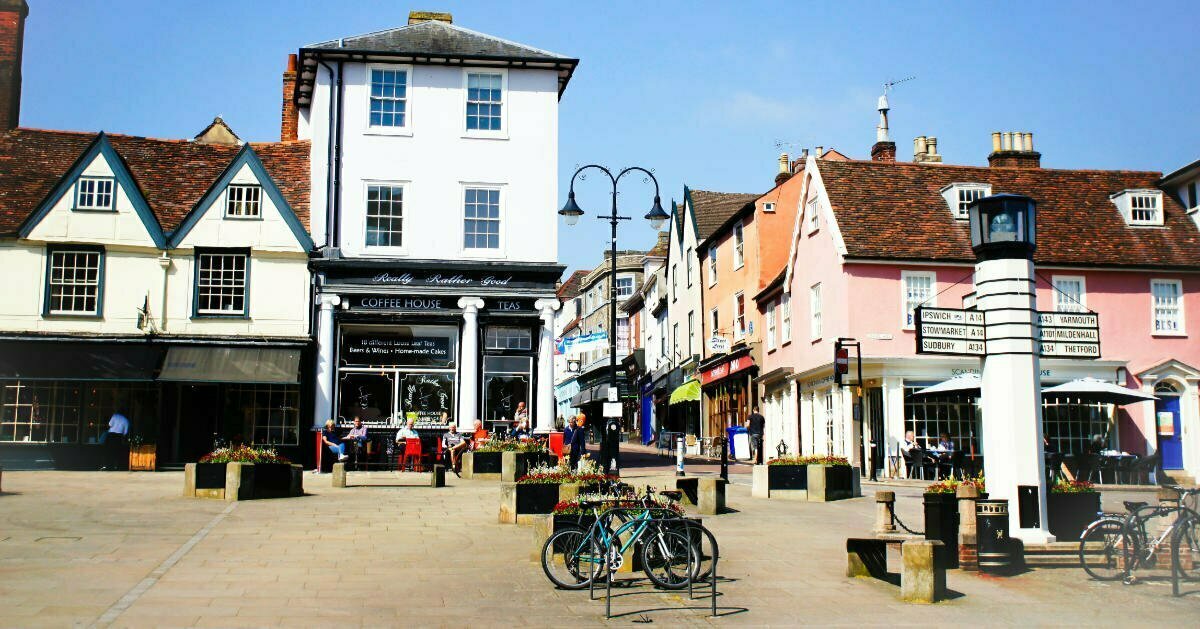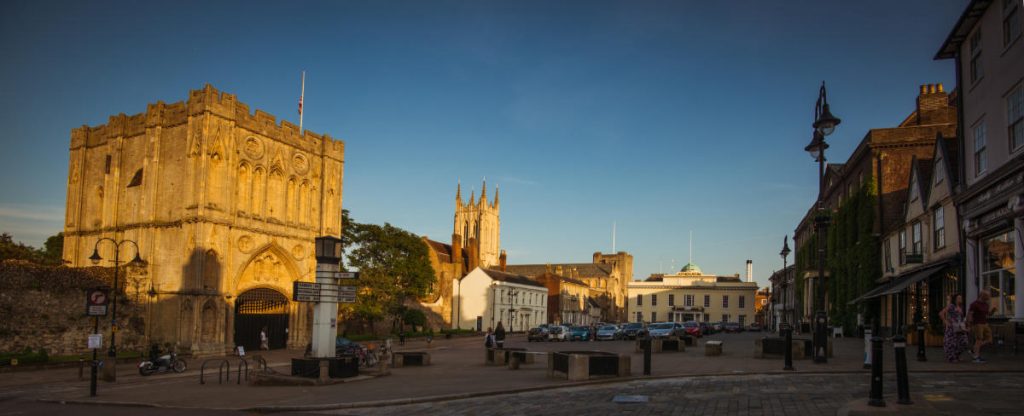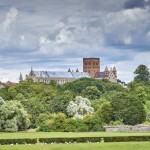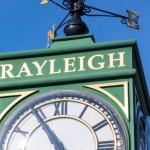
A market town, cathedral town, and historic site of Bury St Edmunds Abbey.
Bury St Edmunds is the kind of quaint English town that made the Normans want to invade. It’s the kind of town that the Vikings looked at and decided they wanted it. Not only is it the home of Silver Spoon sugar, but it’s also one of the few English towns built in a grid shape as designed by an Abbot. There are lots of things that make this place remarkable, you could say.
We want to go right back to the start of time with this town, to find out what the best bits are. We are on a mission to source the best holiday and staycation destinations in Britain. How will Bury St Edmunds add up? Let’s find out.
The Early History of Bury St Edmunds
Bury St Edmunds was once known as Beodericsworth. The “Bury” part of the name means it was a fort town. The St Edmunds part refers to St Edmund who was killed by the Vikings in 869. Killed is an understatement. The Vikings tried to get him to renounce Christianity and he refused. They tied him to a tree, shot him through with arrows, and then beheaded him. Edmund was a close ally of Alfred of Wessex, another Christian king, and the man whose lineage eventually united England under one banner.
That lovely fable aside, let’s talk about where this town came from. Before the town belonged to Edmund, it belonged to Beodric. The town formed around this Lord’s manor house, which would have held a fort at some point. Edmund was crowned in this town in 856. By 870, the King of East Anglia was beheaded etc, and miracles happened after his burial at Hoxne. The town was renamed thereafter.
Even before this, though, the town had a history with the church. King Sigebert, one of Edmund’s predecessors, founded a monastery in the town in 630. Some sources have the name of the town at the time as Bedric’s Worth. Any town with the -worth suffix is a town that was enclosed in some way, either by a stockade or a fort. When Edmund died, his remains were interred at the monastery. King Canute replaced the monastery with an abbey in the 1100s. King Sigebert actually retired to the monastery in his old age, as is recorded in the Liber Eliensis[i].
King Athelstan made the church built for Edmund collegiate in 925, further to its formal renaming in 903. King Cnut had to rebuild the town and the abbey in 1020 when Danes raided and destroyed it. By the time of the Domesday Survey, Bury was already an important large town of substantial numbers.
The bury of St Edmunds had 207 households in 1086. All of the lands belonged to the Abbey, so it is a simple entry. There were 27 smallholders living in the town, with 30 priests in the abbey and 150 “others”. The nature of the others is not specified. They may have been workers, they may have been civilians that kept the bread baking and the priests happy, or they may have been slaves. At that time, the church was renowned for its part in keeping slaves.
The land included 2 mills and 2 salt houses. The annual value was 20 pounds per year. Despite the Normans invading in 1066, the abbey did not change hands and remained the possession of the church. This was back in the day when you respected the church, even if you invaded her servant’s countries. Classy.
The Medieval Era
Let’s move away from the early days and into the middle ages. In 1140, the Moyse’s Hall Museum’s building opened. In 1184, the local St Saviour’s Hospital opened after being commissioned by the Abbot Samson of the abbey.
Bury St Edmunds received a royal visitation from King John twice, once in 1201 and again in 1203. A few years later, in 1214, he would return to the Abbey Church where his nobles presented him with the document that later became the Magna Carta. Henry III also attended Bury St Edmunds. In 1272 he moved the entire parliament here. His descendants repeated his move in 1296, when King Edward I held parliament here, too.
Kings and queens continued to visit this luxurious town over the years. In the 1300s, the town inherited a cloth-making trade that catapulted them to national acclaim. In 1326, Edward II stayed in Bury for Christmas Day. The following year, a riot saw the abbey damaged and looted by locals. The peasantry was led by their Aldermen and assisted by clergymen. Altogether, 19 men were sentenced to death as a result of the riots.
The Abbeygate became a permanent feature thereafter, to keep out the riff-raff if they had to. It didn’t stop the growing resentment in the streets of the town, however. The problem with church held lands is that the church grew fatter while the people stayed poor. The Peasants Revolt of 1381 saw insurgents storm the abbey, kill the abbot, and behead the Lord Chief Justice inside the abbey itself.
In 1433, Henry VI stayed in the abbey for four whole months. He moved in on Christmas Eve. His successor visited in 1486. Between the two, the Duke of Gloucester was found guilty of treason and arrested. He was Henry IV’s, fourth son. He died in captivity of unknown (or unrecorded) circumstances. He had only been there for a few days.
Despite both his predecessors loving the abbey and spending time there, Henry VIII destroyed it. In 1550, the first grammar school opened in town. 5 years later, the town burned 5 martyrs at the stake. Mary, I burned a total of 17 martyrs at the stake here. You can visit the Martyr’s Memorial in the Abbey Precincts. The martyrs were all protestants. Complete senselessness.
Town Charter
In 1578 Queen Elizabeth visited. By 1606, James, I granted them a charter. This lets the town hold a market and an annual fair. A fire in 1608 destroyed 160+ buildings in town. The loss estimated by officials sat above £60,000. Back then, that was a fortune.
The plague struck Bury in 1636 and ultimately led to the Peasants Revolt. The landowners were still expecting the same returns from the serfdom, and the peasants were unable to work to the same scale. Things had to change. King Richard’s forces put down the uprising, but not before a group of mounted rebels captured/beheaded the Chief Justices of several towns – plus the hated Archbishop of Canterbury.
The town executed 40 people as witches in 1640. They hanged them. In 1644 the town was engulfed in fire. We’re not saying the two were related but…
Matthew Hopkins, the man who found more than 200 people guilty of witchcraft throughout East Anglia, was tried by his own techniques in 1647. He was the idiot that said if you floated you were a witch and should die, and if you didn’t float you went to heaven. Moron. Rightfully, the people tied him to a paddle, put him into the river, and he floated, so they hanged him. Do you know the scene in Monty Python with the duck? He hung by the neck until he was dead. Two years later Sir Matthew Haled sentenced another two residents to death for witchcraft. Sure were a lot of witches in Bury.
Let’s take a break after all that death and talk about some fun facts if we can find any.
Fun Trivia about Bury St Edmunds
In this section of any given travel guide, our team like to dish the dirt on the area they are researching. What sort of cool/morbid/informative/upsetting/miraculous things have happened here over the years? Here are some fun facts you probably didn’t know about Bury St Edmunds to help you find out.
- Bury St Edmunds was home to the original patron Saint of England called – not surprisingly Saint Edmund
- One of the monks of the abbey named John Lydgate translated the Troy Book which recounted the trojan war. He later translated the Siege of Thebes from French in 1420.
- The town was involved in numerous witch trials between 1599 & 1694. The 1662 trial was allegedly the model for the infamous Salem Witch Trials in Massachusetts in 1692.
- In 1645, 18 suspected witches were hanged in one day. Typically most were women but the victims included John Lowes the Vicar of nearby Brandeston.
- St Mary’s Church houses the remains of Mary Tudor, Henry VIII’s favourite sister and the woman for whom the Mary Rose earned its name.
- M. Barrie visited the West Stow schoolhouse, yards away from a tree that is raised up on its exposed roots. The tree is nicknamed ‘the walking tree’ and gave Barrie inspiration for Peter Pan.
- The town’s Athenaeum has a Victorian Astronomical Observatory inside if you care to hunt it down.
Wasn’t that refreshing? Let’s look back through the Industrial era of the area and see if we can’t find out what made the town grow so big.
The Industrial Revolution in Bury St Edmunds
The Unitarian Meeting House opened in 1711. In 1780, the Market Cross received completion. A catholic chapel opened here in 1791 and the first brewery in town, the Greene King, opened in 1799. This was the start of the Industrial Revolution in the Bury of St Edmunds. By the 1800s, it truly kicked off.
A gaol opened in 1805 – that’s gaol, not jail. It cost £30,000 to build. It held 140 inmates at a time. Those were the days. In 1819 the Theatre Royal opened, built by William Wilkins. He was the architect responsible for the design of the National Gallery. The botanic gardens in Bury St Edmunds came about in the same century. In 1820 St James’s Church received extensive refurbishment. Five years later the town became home to the Suffolk General Hospital.
In 1937 the St Edmund Roman Catholic Church opened and in 1840 the Church of St John the Evangelist followed. The old Clapton Asylum opened in 1842, oddly with a school attached to it.
In 1847 the town finally received a train station and railway line. The population stood at 13,900 in 1851. The Athenaeum opened in 1854 and contained a library and museum. In 1861 the population was 13,316 people. The following year the town built a corn exchange and in 1864 they spent £13,000 upgrading their town hall. By the end of the century, there were over 16 thousand people living in Bury St Edmunds.
Modern Times in Bury

Image: Tom Soper Photography/Shutterstock.com
Moving into the 1900s, the scouts took up residence in the town in 1908. The group formed in the 1st Bury of St Edmunds claim to be the oldest in Britain that still goes today. In 1911, the population grew to 16,785. In 1925, the British Sugar Factory opened in town, producing plenty of new jobs in the area. The Pillar of Salt street sign has existed since 1935. It was the first internally illuminated street sign.
In 1951 St George’s Church was a community centre. It was converted into a church in 1967. The cathedral added an extension in the 60s. By 1961 the population of the town had swelled to 21,179 and a year later in 1962, All Saints Church opened. In 1974 a tragic accident saw 17 members of the Bury St Edmunds rugby club killed when their Turkish Airlines flight came down. 346 lives were lost.
In the ’90s a short-lived trial of internet benches failed here. In 99, the Old Cannon Brewery opened. The population at the start of the century was 35,015. The New Tower on the cathedral finished in 2005 with the opening celebration taking place. In 2007, the town extensively refurbished the theatre.
Modern Bury St Edmunds is a great place to live and a better place to raise your kids. In terms of visiting it, there’s plenty to see and do no matter how long you stay for. We’ll discuss some famous faces from the town, then talk about the best things to see and do here.
Famous People from Bury St Edmunds
In this section of the travel guide, we like to review who the famous people to have come from the area are. Here are the famous faces you might see down the supermarket… except the dead ones, of course:
- Film producer Matthew Vaughn, was behind Lock, Stock, and Two Smoking Barrels.
- English actor John Le Mesurier was from here, he was the sergeant in Dad’s Army.
- Actor Bob Hoskins was a resident.
- Artis Thaddeus Holownia, an English born Canadian, was born here.
- Several famous clergymen, including Nicholas Battely, the Bishops Blomfield, and Richard de Bury.
Now that’s out the way, we can get to the part of the article that every tourist skips ahead to. We don’t want to know the history! We want to know what the best attractions in the area are.
Top Attractions in Bury St Edmunds
If you wanted to spend a week or two holidaying at home, would Bury St Edmunds be a nice place to pass the time? Here’s all you need to know about the best things to see and do in town.
Historic Sites and Landmarks
The Greene King Brewery is still going to this day. That’s an impressive feat. You can take a tour but it’s adults-only if you want to sample the wares. This is an enjoyable experience that people say is interesting in learning the processes. The tasting sessions aren’t so shabby, either. It’s been there so long it’s a local landmark.
Let’s not forget about the Cathedral, which is striking from all angles. You can catch a service or engage with the church here. But the gardens are the best part.
Another huge landmark attraction in the town is the Theatre Royal of Bury St Edmunds. Catch a show or simply marvel at the architecture. Join a drama group or find entertainment within the walls here. If you prefer something more modern, head to the Apex theatre, instead. They run lunchtime yoga sessions and all sorts. It’s more likely to have your favourite band gigging than the Theatre Royal.
Galleries and Museums
Although an outdoor attraction, history lovers will adore the Anglo-Saxon rebuilt village out in the West Stow Country Park. Of course, the country park itself has lots to offer, too. It’s an outdoor attraction with forests, meadows, and open water. You can hike, picnic, or get back to nature there. If you like history though, that rebuilt town is really cool to see. It harkens back to the pre-Viking but post-Roman times.
Visit the Moyse’s Hall Museum, which is still in its original house. It’s been going strong for 900 years now, still in the same place. It has been voted the most family-friendly museum in Surrey. The museum charts the course of time throughout the area, including regalia from the wars and artwork and sculptures created in the area.
There is also the Ickworth monument nearby. Ickworth is run by the National Trust as a graded building that you can visit and tour. Its remarkable shape and gorgeous grounds make it a favourite attraction of many all over the country.
Outdoor Attractions
Although people come here to see the Cathedral, they stay for the Abbey Gardens. In high summer and spring, these flower beds are so perfectly tended that they earn visitors from all over the county. They are some of Surrey’s finest. There are lawns, hedges, and well-preserved statues to glance over as well.
One of the best places to sunbathe in town is in Nowton Park. There are daffodils aplenty here in spring, but it’s a great place to take the kiddies for an adventure. It has its own café and sprawls across some 200 acres of the countryside. It’s got an arboretum, too, but you have to hunt to find it. Just kidding, it’s all clearly signposted. Nobody wants you to get lost in there.
Bury St Edmunds has their own vineyards. Go and see the Wyken Vineyards, complete with their own country shop and exquisite gardens. Browse the hedgerows or buy from the farm there. It’s a beautiful day out in the countryside.
Sports and Recreation
The local football team is Bury Town FC. They play at Bury St Edmunds grounds. You can find them in the Isthmian League North Division for the moment.
Since this is an English town and we English like our golf, you can have a choice of clubs. There’s the Bury St Edmunds club, the Suffolk Golf Club, or the Bury Golf Range to choose from.
There is a RUFC in Bury St Edmunds, you will find them here.
Shopping and Retail
There are plenty of shops in the town centre where you can buy gifts. There is also the Arc Shopping Centre in the town centre, but there’s the Western Way Retail Park to the north and west, too.
Other Notable Bury Attractions
If you have made it this far and you still haven’t found the ideal attraction for you, try the following things:
- Those that prefer the cinema to the theatre can find a show at the Abbeygate.
- Visit Bury St Edmunds Market on a Saturday in the town centre.
- Go see the ruins of the old abbey.
- Visit the Undley Pumpkin Patch and Maize Maze at the end of summer
- Go to Rougham and see the control tower and aviation museum
- Visit the Bardwell Windmill
Even if you have to source your entertainment from the surrounding areas, you will always find something that suits you to do in Bury St Edmunds.
How to get to Bury St Edmunds
Now you are up to date on everything we know about Bury St Edmunds – except how you actually get there. Follow these directions and hopefully, you won’t end up in the sea.
By Road
Follow the M1/A1 north out of London.
By Rail
Bury St Edmunds train station is on the Greater Anglia line.
Via Air
The nearest international airport is London Stanstead.
By Sea
Alas, you are landlocked.
Got a Few Minutes?
If you are still looking for more, head back to our site and find our many travel guides there. Alternatively, follow us on Facebook to lend a hand in spreading the travel guide goodness. Your friends might even thank you for it.
Header Image Tom Gowanlock
[i] http://www.stedmundsburychronicle.co.uk/Chronicle/bury/bseromans.htm



